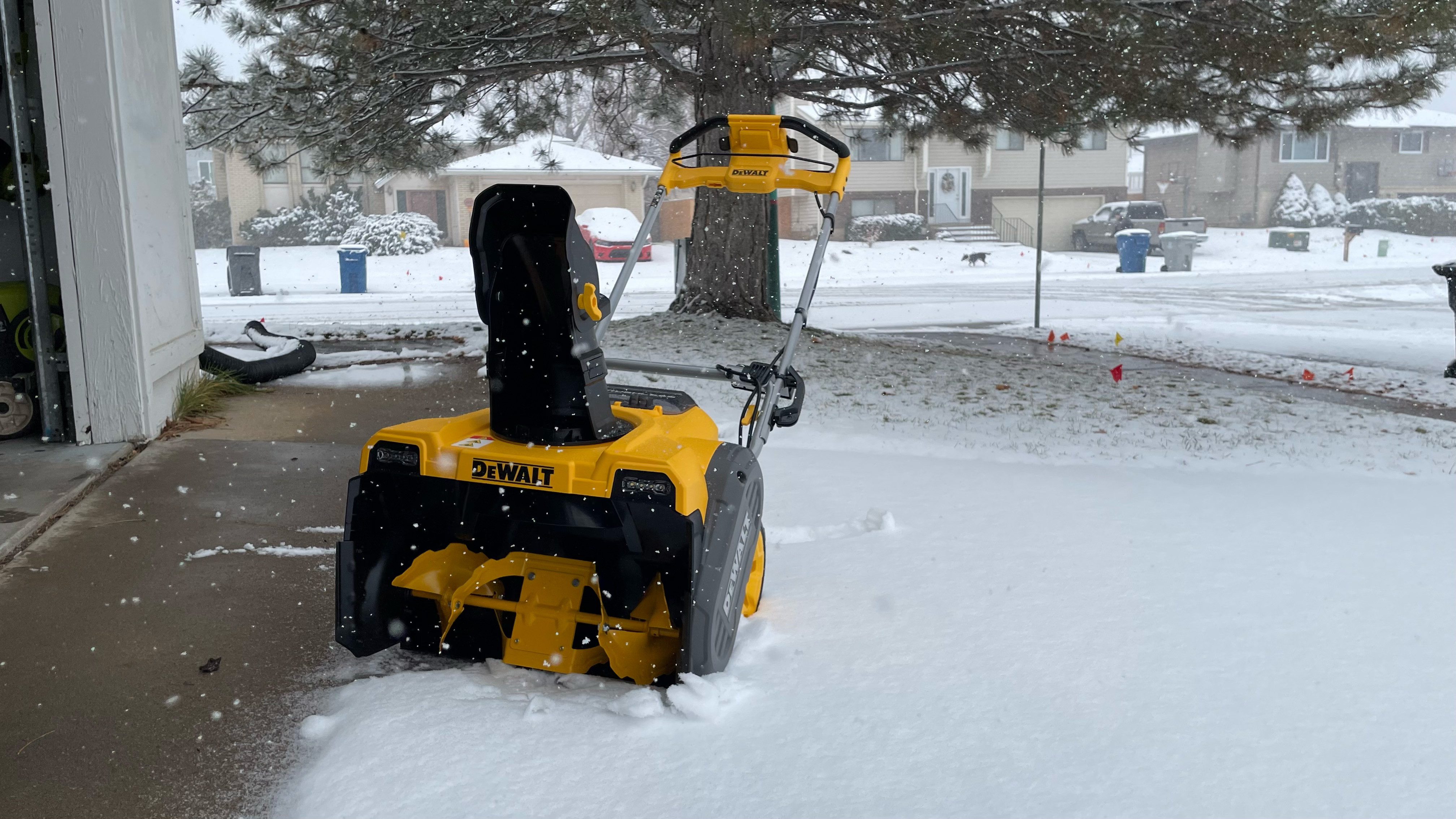
On the forecast, after a month of rather unseasonably warm December weather, there was finally a storm brewing over the weekend. I had the Dewalt 60V Max Single-Stage Snow Blower sitting in the box for a month, just waiting to show me what it could do. The first snowstorm we received at the beginning of the weekend was a good test run - a solid four inches of powdery snow that seemed like it would be right in the wheelhouse of a battery-powered single-stage snow blower. On Sunday morning, I woke up to a fresh eight inches of snow overnight. With this much snow available, it made me curious to find out if this Dewalt Snow Blower would be the best snow blower for the job. After the combination of the two storms, there was enough snow in the mouth of my driveway that it crossed my mind: is a snow plow worth it? I couldn’t wait to find out.
I tested the Dewalt 60V Max Single-Stage Snow Blower over a weekend, which resulted in over a foot of total snowfall. I tested the snow blower to remove about four inches of snow to clear my entire property, including my driveway, my sidewalks, and my patio in the backyard. I also tested how well it did, clearing about eight inches of snow on my walkways after another night of heavy snowfall. I also tested the battery life by timing how long the machine would last during normal use, how far the machine tossed snow, maneuverability, and lastly, how loud the machine was.
After a weekend that seemed like all I did was remove snow from my driveways and sidewalks, I have a clear picture of whether you should add this battery-powered snow blower to your winter clearing arsenal. Read on to find out.
Dewalt 60V Max Single-Stage Snow Blower: Key specs
Dewalt 60V Max Single-Stage Snow Blower: First Impressions
One of the first things that I noticed compared to other battery-powered snow blowers that I have tested was that the auger was metal. All other single-stage, battery-powered snow blowers to this point that I have tested feature plastic augers. Metal augers are more durable and visually represented that this snow blower was not built like other battery-operated ones.
Another first impression I had when I was assembling the machine (which only takes about five minutes) was that there wasn’t a handle to manually rotate the chute. Instead, you have two paddle-shifter-like controls (like you would see on the steering wheel of some cars) that rotate the chute left and right. This ended up being an amazingly convenient feature, but more on that in our design and performance sections.
Even with the metal augers, which did add a little bit of weight to the machine, overall, the snow blower remained lightweight and easy to maneuver around. And when you’re all done, the handle quickly and easily folds forward for more compact storage. I thought that was a nice touch.
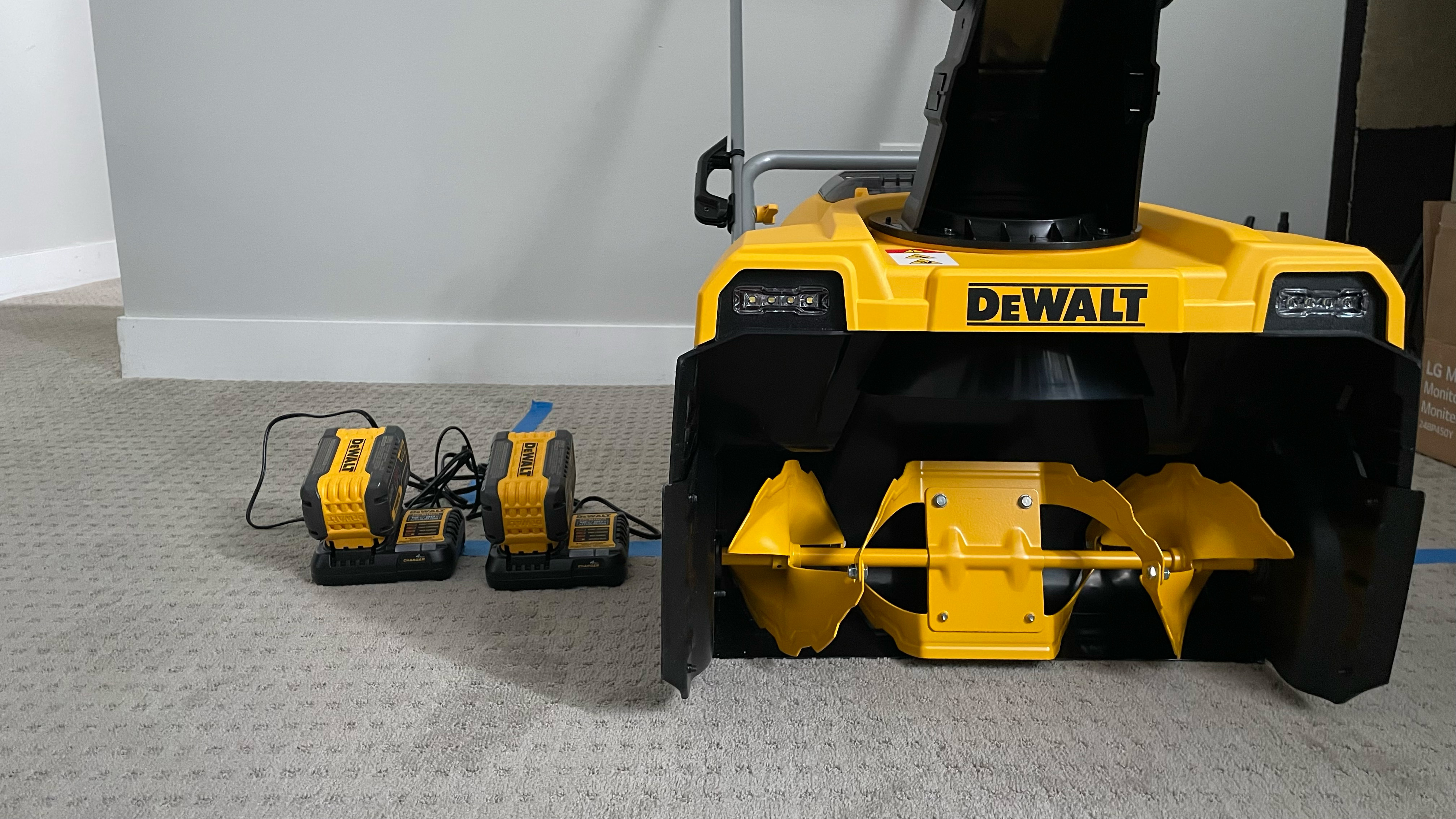
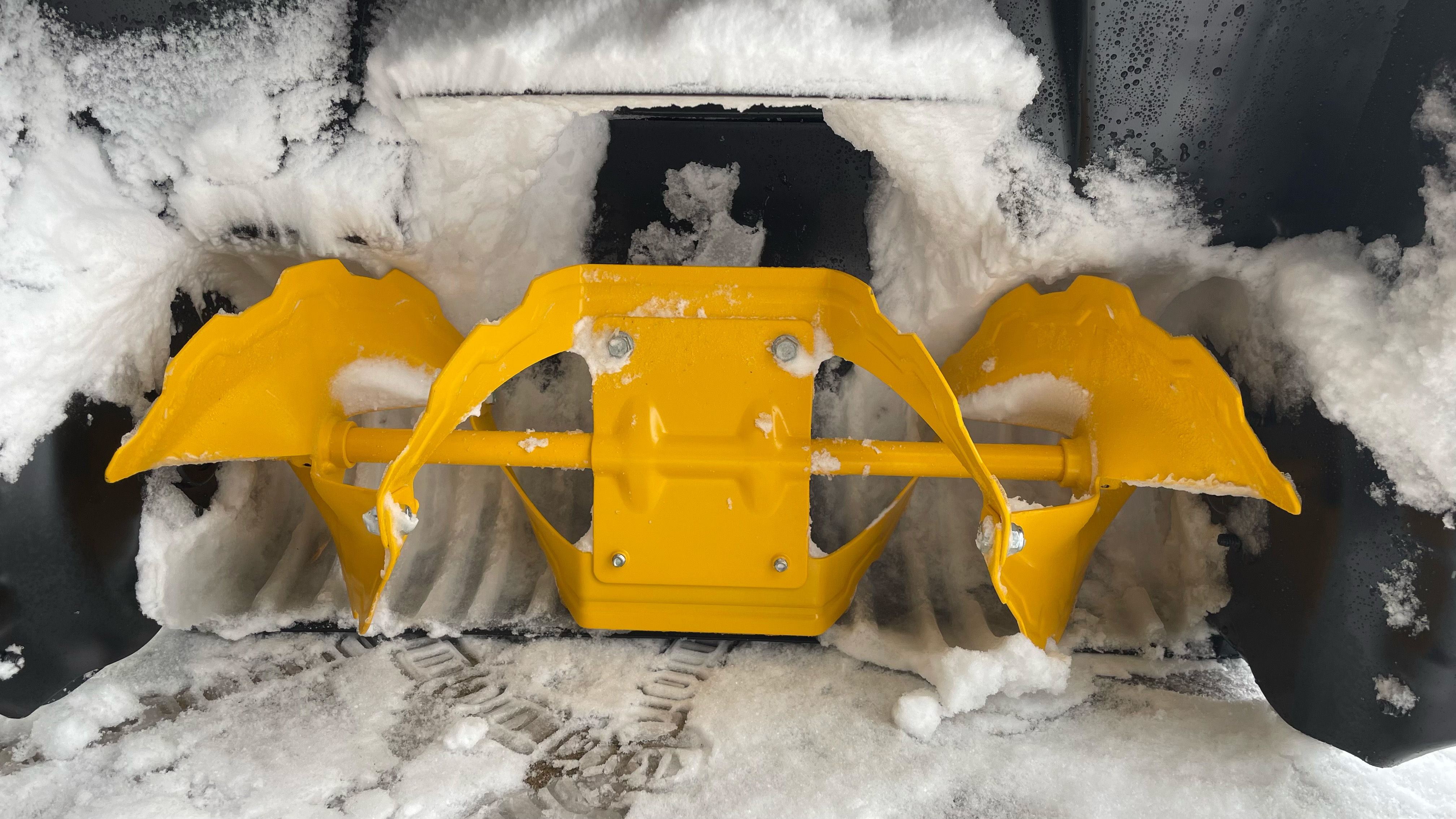
Dewalt 60V Max Single-Stage Snow Blower: Price & availability
The Dewalt 60V Max Single-Stage Snow Blower has a list price of $999.00 across most retailers.
That price includes that snow blower, two battery packs, and two chargers. It’s available to buy direct from DeWalt (both the kit and a tool-only version) and through resellers such as The Home Depot, Acme Tools, and Ace Hardware.
If there is one knock on this snow blower, it is the price; it’s expensive. We’ve seen many battery-powered single-stage snow blowers range anywhere between roughly $250 and $700, so this one certainly leans towards the higher end of the price range.
Score: 1/5
Dewalt 60V Max Single-Stage Snow Blower: Design
I was pleased to see there were metal augers in the mouth of the machine. Simply from a durability perspective, with proper care and maintenance, these augers will last longer compared to their plastic counterparts. In terms of performance, which we’ll discuss in the next section, I believe it helped cut through the snow with great results.
One particular stroke of genius is the two-way electric chute control, or as I have been describing it, the paddle shifters. What is especially nice about this design and placement is you never need to take either hand off the handle ever. You can continue to push the snow blower and adjust the chute simultaneously. So, when you’re turning in one direction or another to start a new pass, you can adjust the chute accordingly. This ultimately saves a lot of time.
Two batteries power the machine, although the manual says that in a pinch, one battery can operate the machine (of course, run time significantly drops with one battery). There is also a button on the handle to change how much power the snow blower uses. There’s a plus for extra power and a leaf for an “eco” mode. Extra power mode can come in handy if the snow is a little wetter, or on a partially light snow day, you can use the eco mode to quickly remove snow without wasting battery power.
Score: 5/5
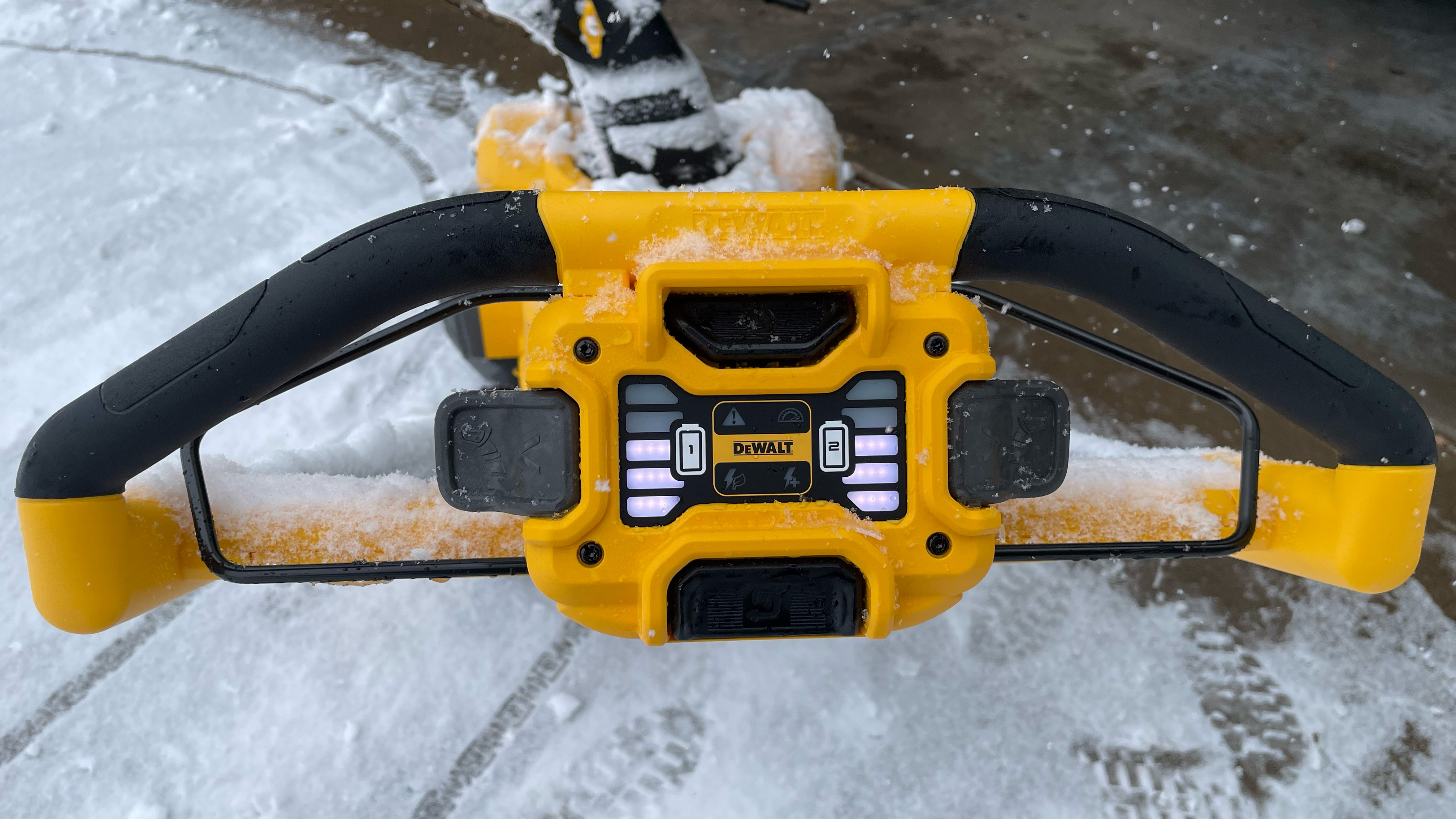
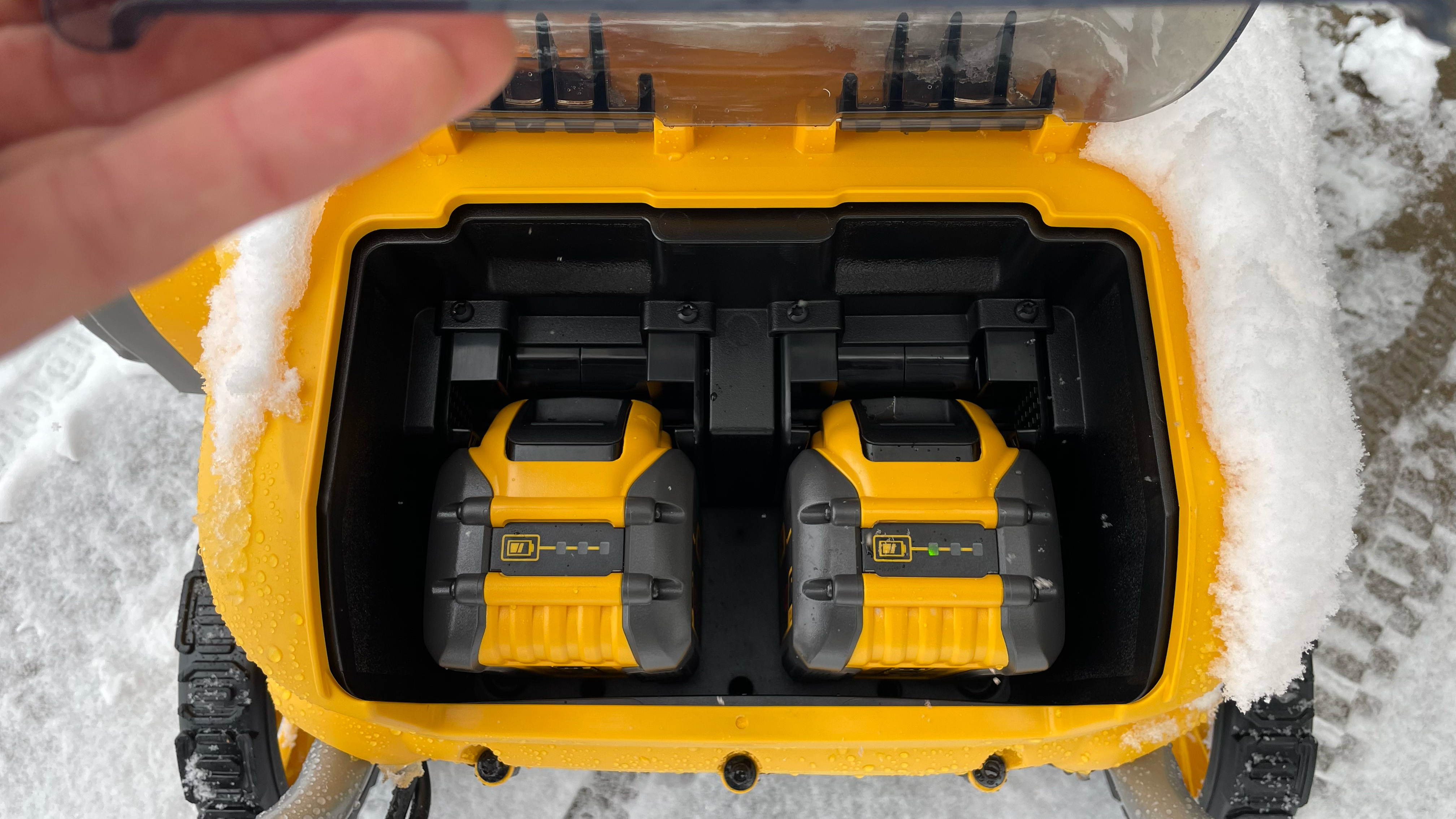
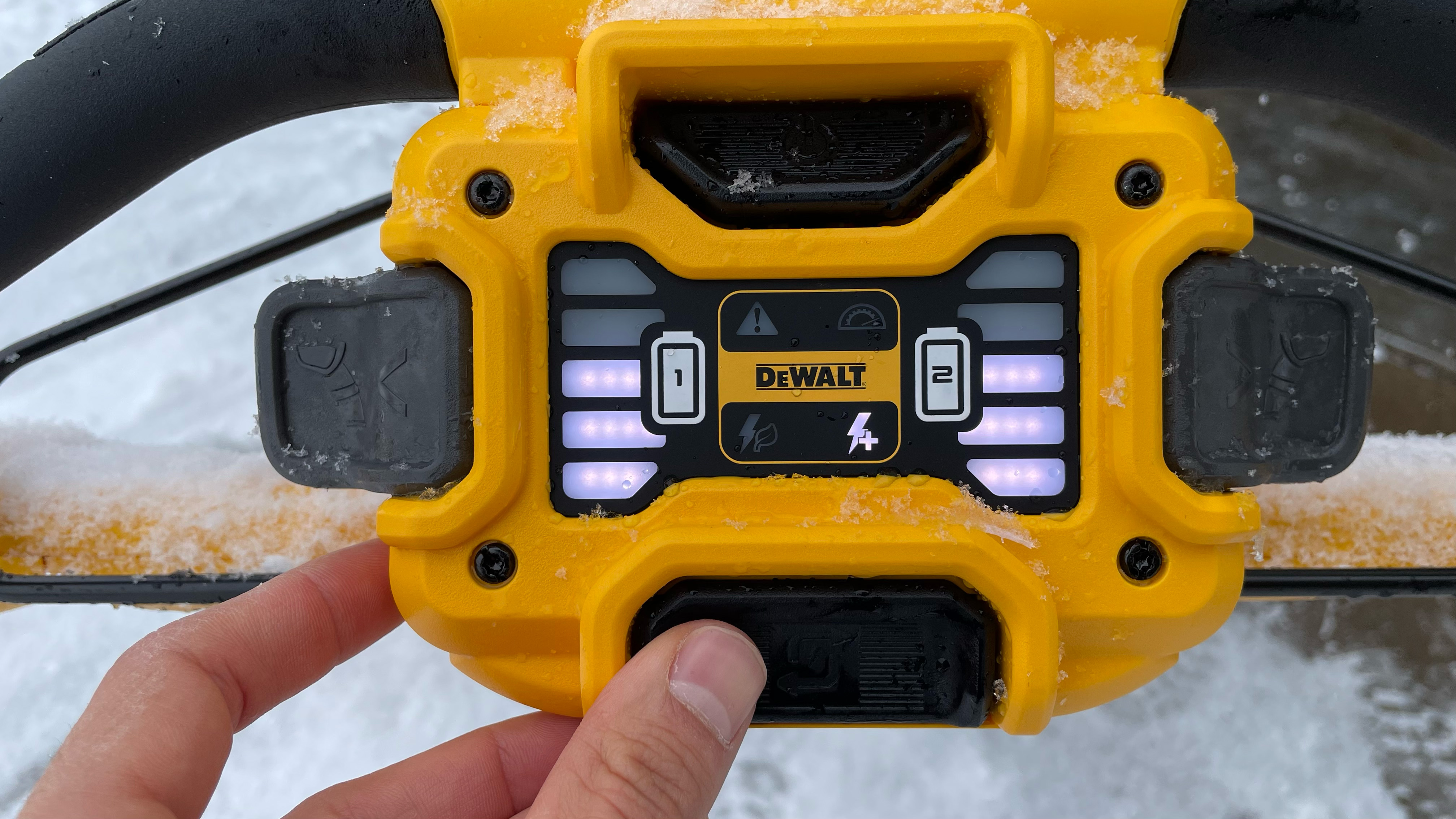
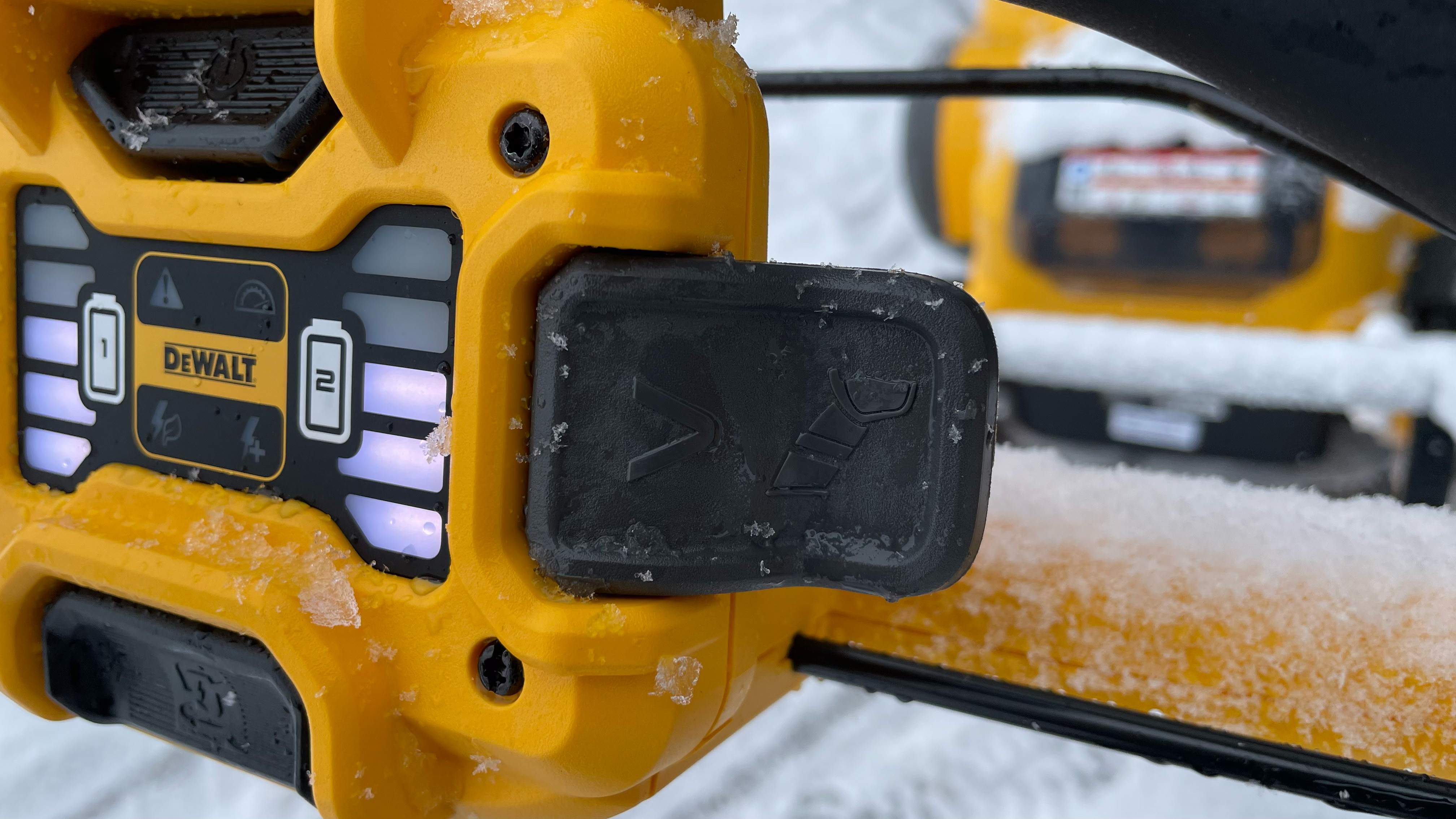
Dewalt 60V Max Single-Stage Snow Blower: Performance
The first time I used the snow blower to clear my property, there were roughly four inches of fresh snow on the ground. My property consists of a two-car driveway with an additional cement parking space to the left of the driveway. I live on a corner lot, so we have two sidewalks to clear – about 150 to 180 feet of sidewalk – a walkway to our front door and a back patio that is roughly 25 feet long by 15 feet wide. It’s a lot of area to clear.
The Dewalt 60V Max Single-Stage Snow Blower didn’t have any issues picking up and removing any of the snow. It never once stalled or powered off because the snow was too thick or heavy to throw. This was a common issue with other battery-powered snow blowers I’ve tested in the past. It plowed right on through.
We’ve discussed how to use a snowblower and the most efficient way to remove snow from your property. My property is a little different. I can’t throw snow on both sides of my driveway because I would be tossing snow directly into my neighbor’s driveway, and that wouldn’t be cool. Because of this, it requires me to move the chute often. And this is where the electric two-way chute adjusters shined for me. With the chute adjusters, I could make a pass, and as I turned to make a new pass, I would simultaneously adjust the chute while I was turning, so when I was ready to start again, the chute would be pointing in the correct direction. No need to stop and twist the chute handle after every pass. This saved me a ton of time and kept me non-stop, removing snow.
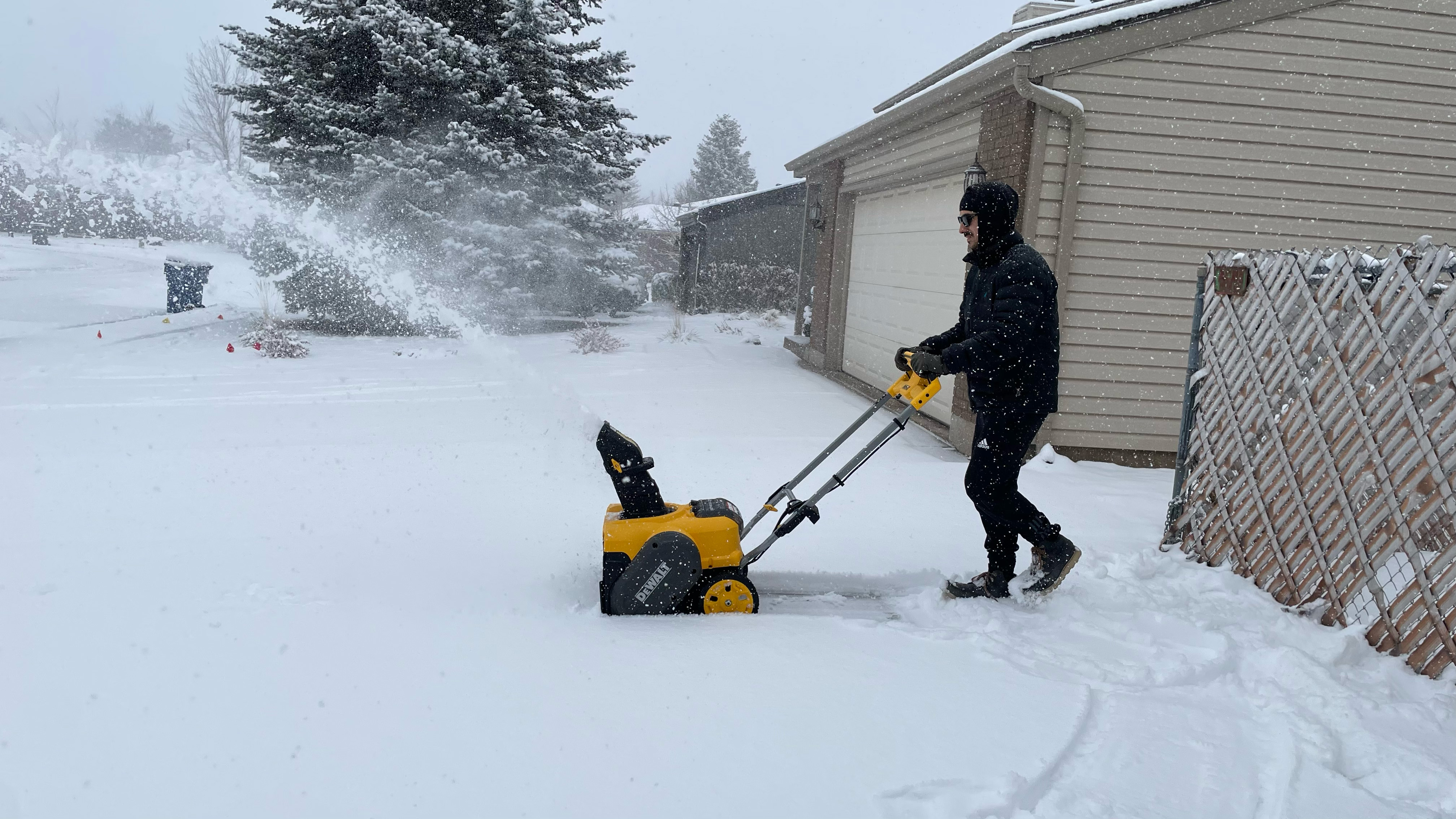
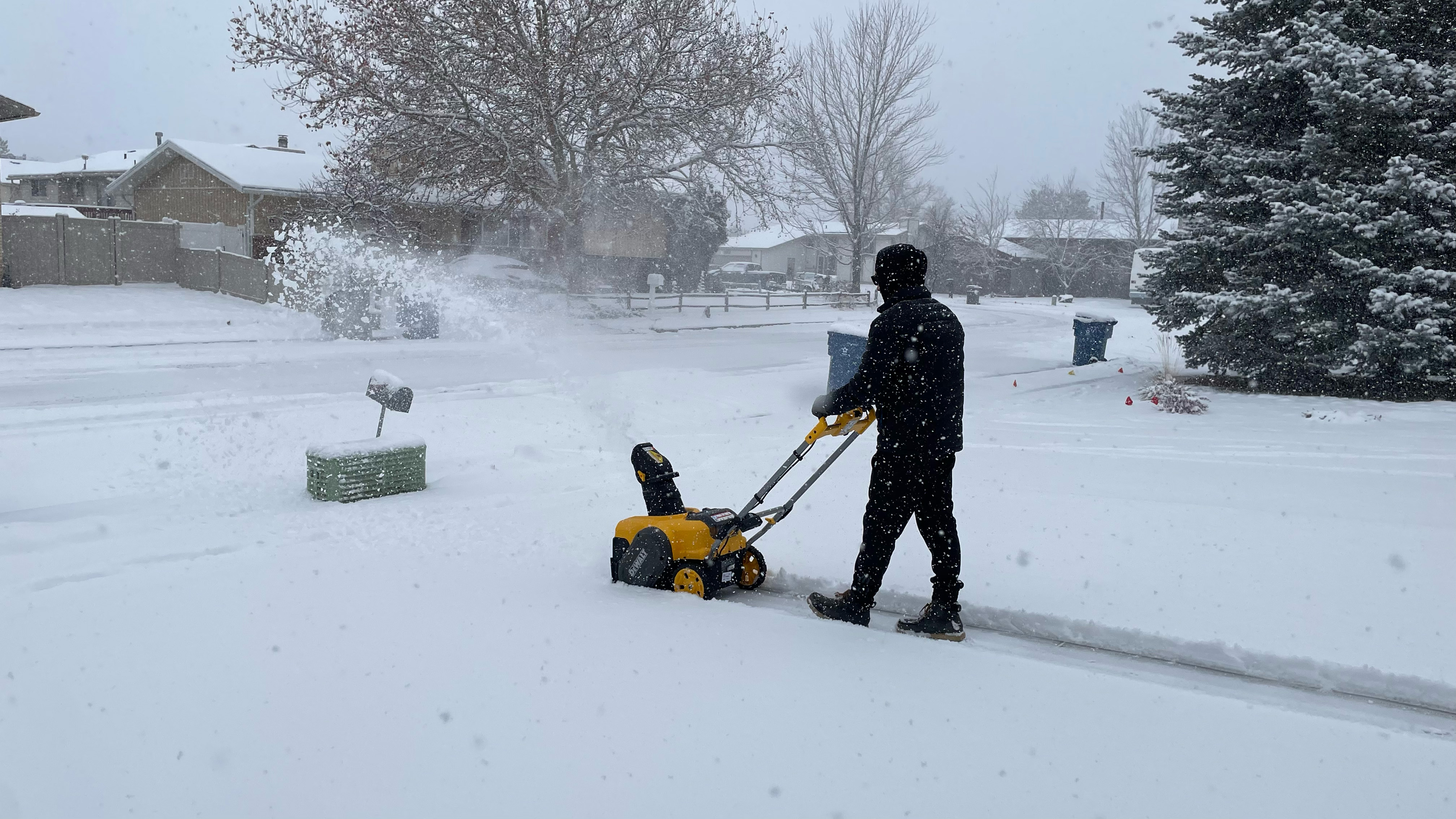
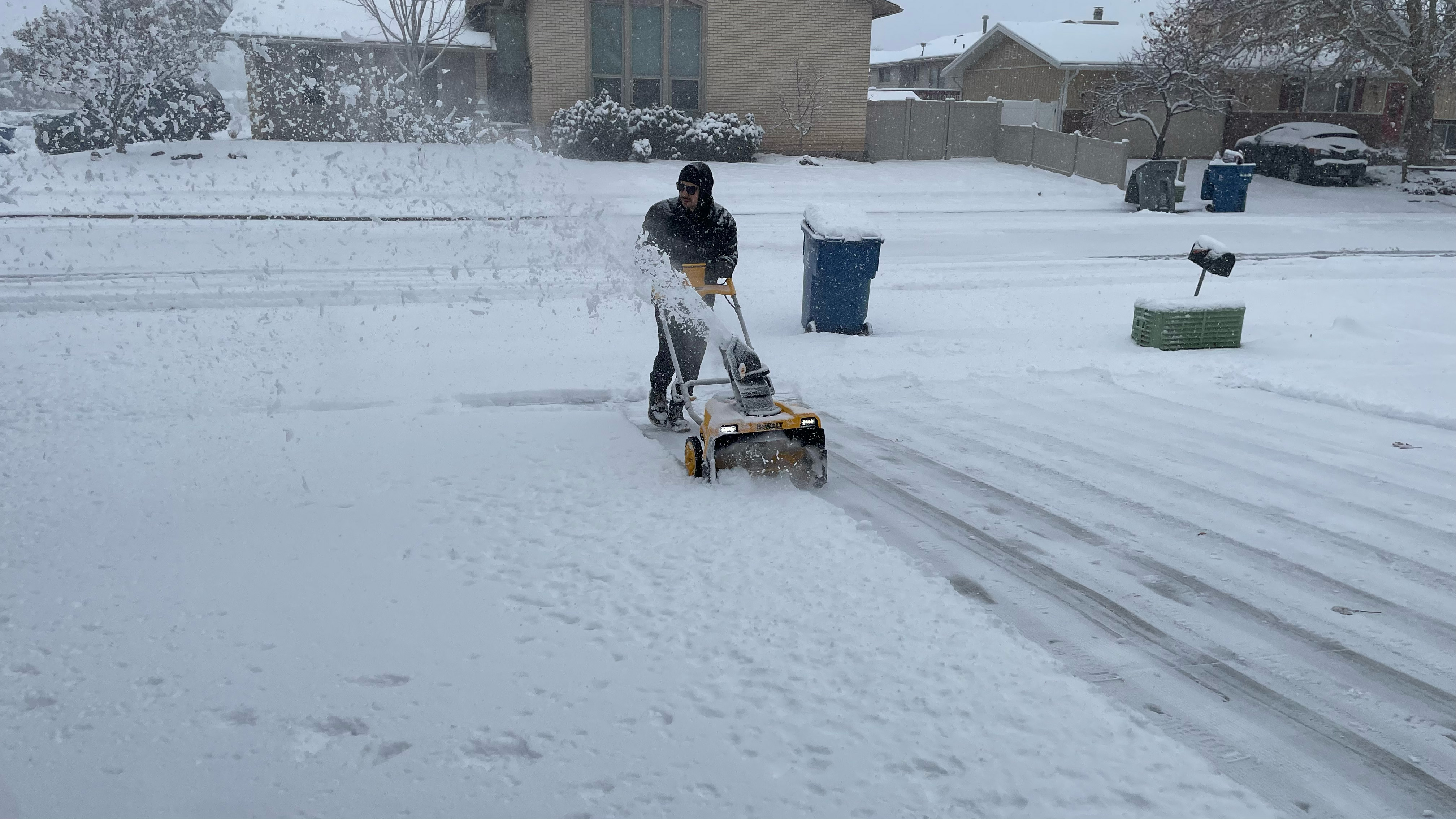
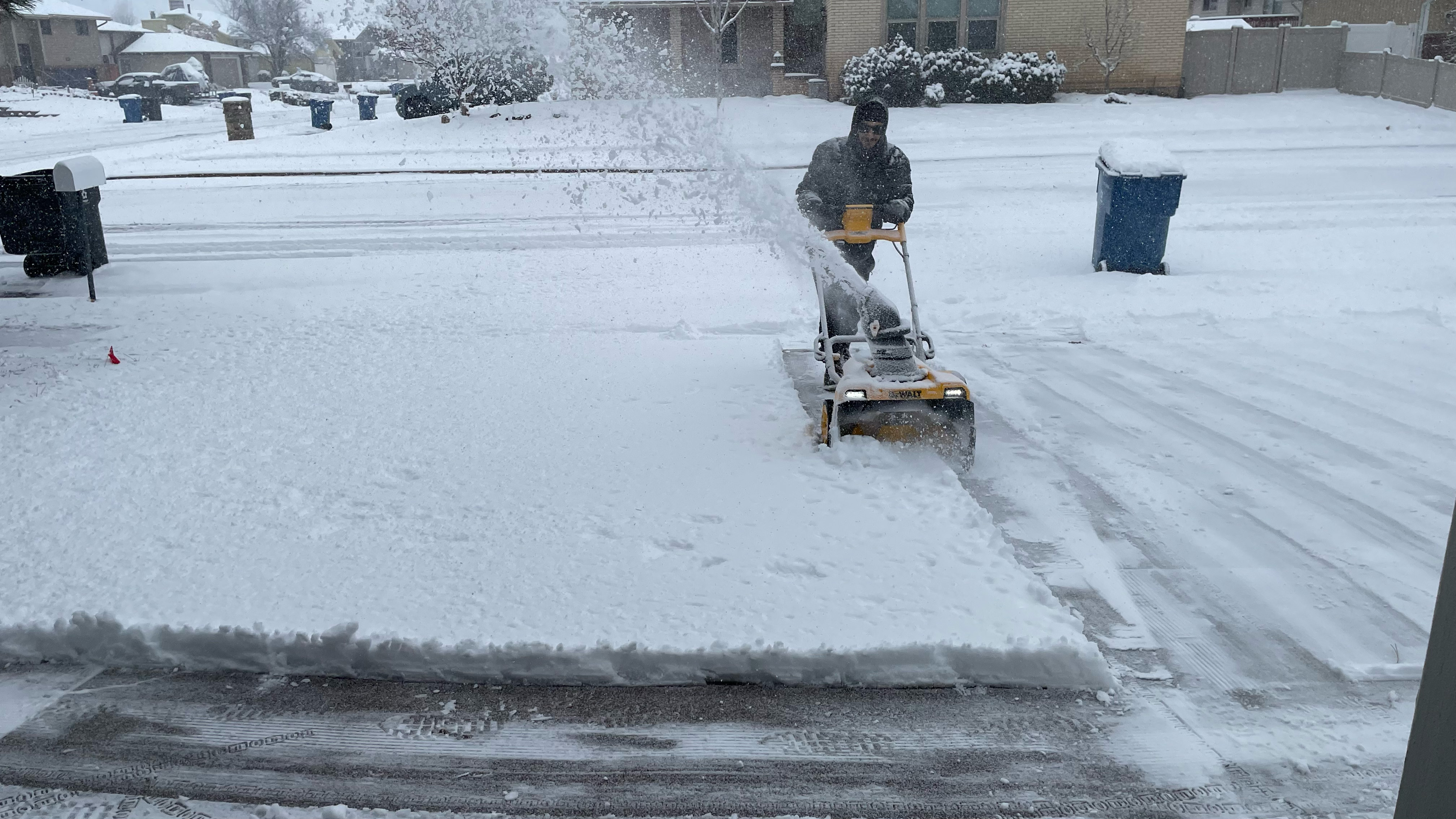
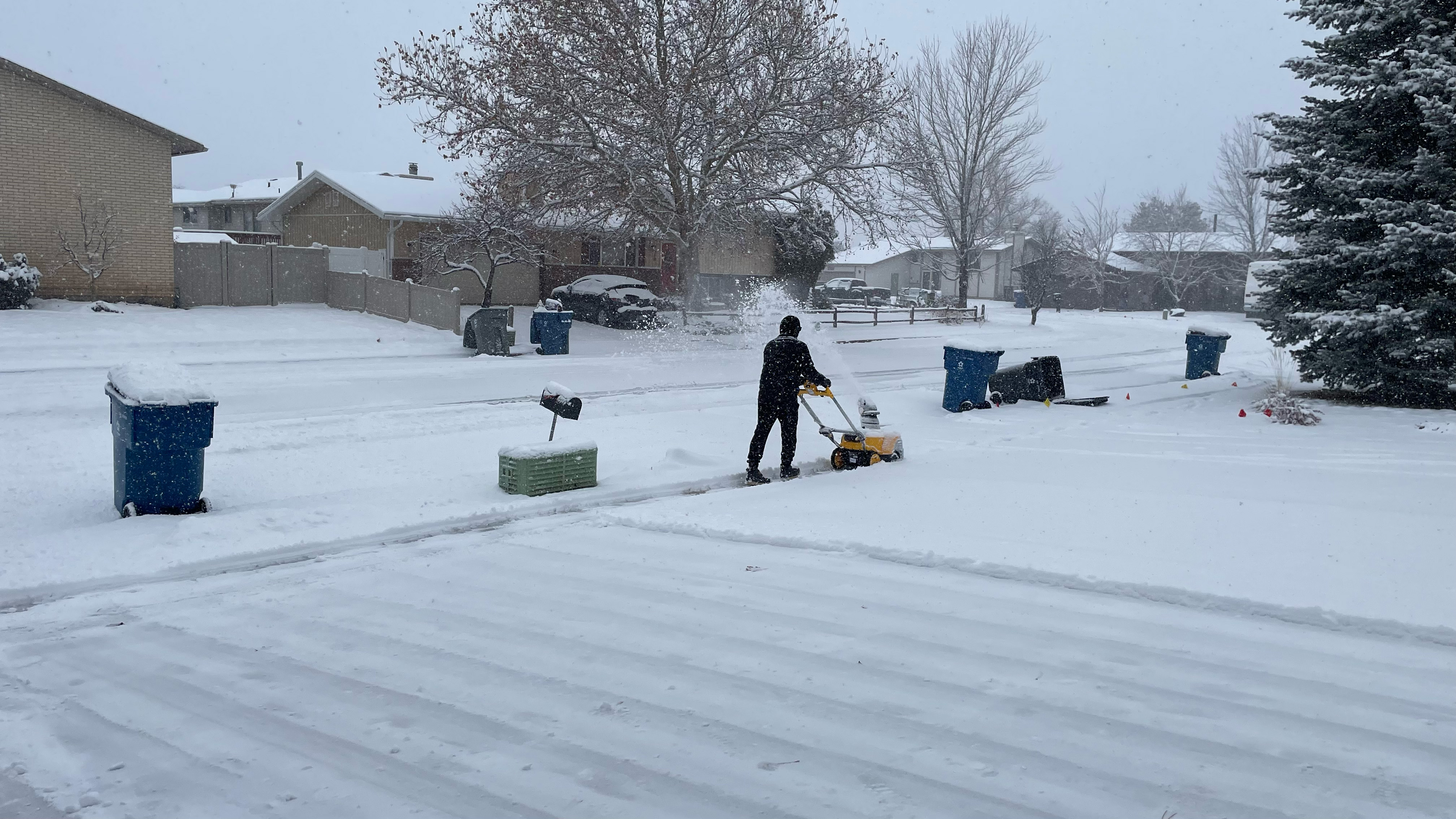
The paddles don’t adjust how high you can toss the snow, though. That is adjusted on the chute itself, but I typically had it set to the highest and farthest possible setting, so that was never too much of an inconvenience. Speaking of, the manufacturer lists that it can toss snow up to 40 feet. In my experience, that number is closer to 15-20 feet. I was able to toss snow from the leftmost side of my driveway to the grass successfully, which is about 18 or so feet. Anything further than that, and I was just tossing snow back into my driveway.
I was able to remove snow from my entire property after about 30 minutes. After that time, I still had close to half of the battery life left. I was impressed, considering other battery-powered snow blowers I had tested were either dead or almost dead by this point. It continued to snow that day, so a few hours later, I took out the Dewalt again and cleared my property until the batteries finally gave way. I was able to squeeze roughly 54 minutes of battery life from the machine, which was 9 minutes better than the 45 minutes listed by Dewalt.
A day later, we got a huge dumping of snow overnight, roughly eight inches. I was curious how the Dewalt would do with that amount of snow. I used it to clear our front sidewalk. It did great. It was able to pick up and throw the snow with no issue. The only real nitpick is the lack of any self-propelling mechanism. With snow that deep and heavy, manually pushing the snowblower forward through the snow began to get taxing. It was difficult to walk behind the blower at a smooth pace. You need to give real effort in pushing. Ideally, you probably don’t want to remove more than five to six inches of snow at a time with this machine, although it can remove more if needed, which is impressive.
The operation is quiet as well. Taking a decibel reader and measuring where I was standing, the machine only makes about 75 dB of sound. When measured by the motor, it makes about 80 dB of sound. For reference, 80 dB is about the noise level of a noisy restaurant – ultimately, it is not bad for a power tool.
Score: 5/5
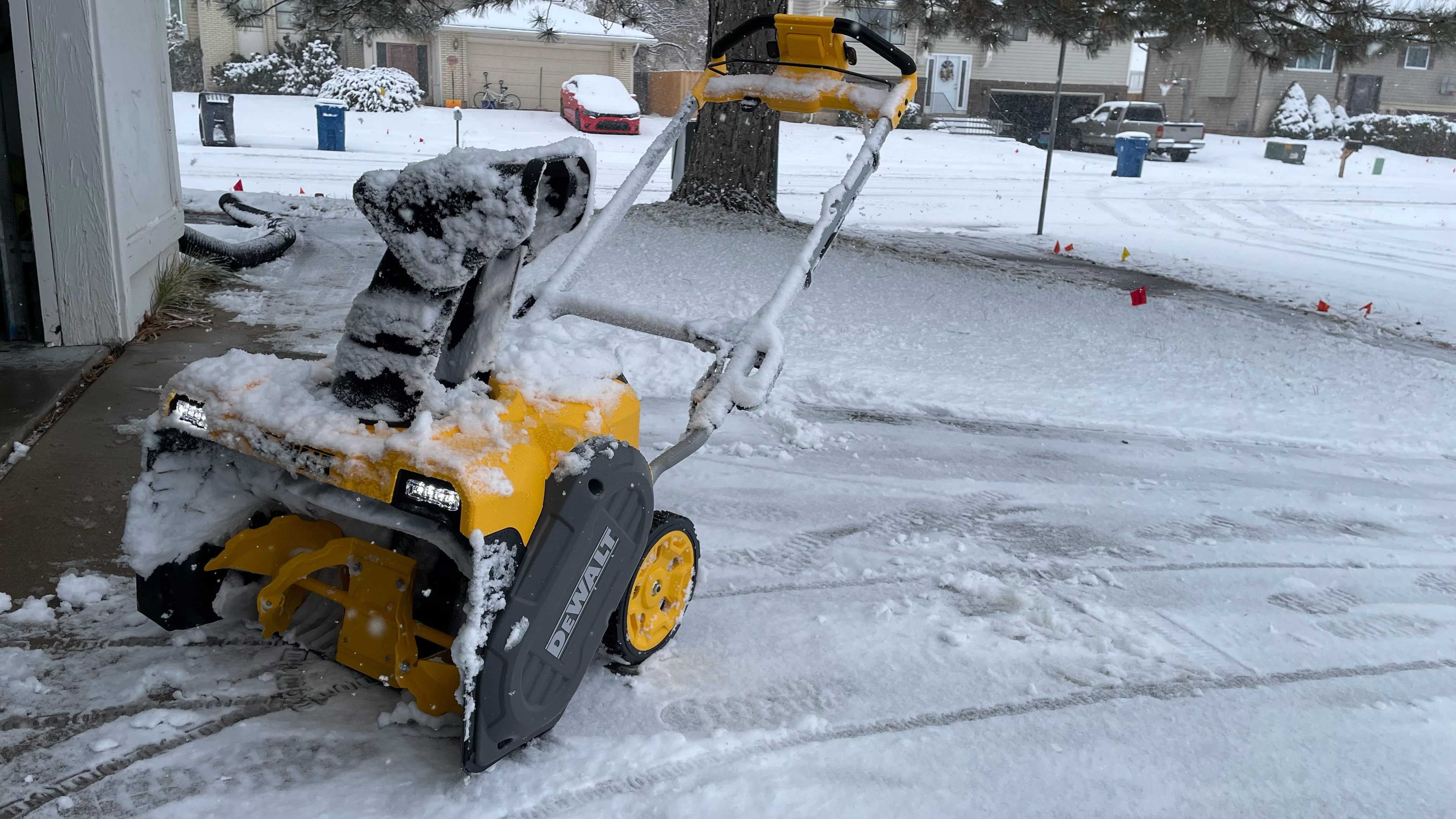
Dewalt 60V Max Single-Stage Snow Blower: Cleaning & Maintenance
If you want to cut down on maintenance, a battery-powered snow blower is the way to go. You don’t have to worry about gas going stale in the motor or checking the oil. For the most part, as long as you keep your batteries charged and stored in a room-temperature area, you’re pretty golden.
Before I started spraying, as I do with all my snow blowers, I used a silicone spray on the augers inside the mouth of the snow blower and chute. This helps prevent snow from sticking. If snow does get stuck while operating, turn off the motor, remove the key, and use a chute cleaner or broomstick to remove the stuck snow. Never put your hand inside of the snow blower. After I was done with the job, I took a small brush and towel to quickly brush off any excess snow and dried the machine off. Keeping the machine dry will help prevent rust from forming on any of the bolts or the augers.
After the snow season has ended, I will use a rust breaker and preventer and spray it on the scraper, augers, and any bolts. I will also coat the mouth and chute with the silicone spray to form a moisture barrier and store the batteries inside of my home until next season.
Should I buy the Dewalt 60V Max Single-Stage Snow Blower?
Buy it if…
Don’t buy it if…
Dewalt 60V Max Single-Stage Snow Blower: How Does it Compare?
I tested the Snow Joe 48V Max Cordless Snow Blower during this same winter season. The Dewalt has metal augers compared to the plastic Snow Joe augers, and the Dewalt has better battery life. I was able to remove snow for over 50 minutes with the Dewalt, while the Snow Joe started to lose power after 27 minutes. The Dewalt is more expensive than the Snow Joe, so that could be a determining factor if you’re looking to save a few bucks and have a smaller area to clear.
Compared to the Greenworks Elite Sn-200-T, another battery-powered model I tested, the Dewalt is the better-performing machine. I never had any issue with the scraper catching and getting stuck on the ground as I did with the Greenworks model, and the power and battery life were better with the Dewalt.
When compared to the gas-powered Toro Power Max 824 OE 24-inch Snow Blower, the Dewalt has better maneuverability, but obviously, nowhere near the snow-clearing power or throwing ability as a two-stage snow blower. I wouldn't try to tackle snow that was plowed into the mouth of your driveway with the Dewalt, which was easy work for the Toro. But the Dewalt Snow Blower is about $300 cheaper and removes plenty of snow.
How I tested the Dewalt 60V Max Single-Stage Snow Blower
I tested the snow blower over a weekend of heavy snowfall, where we received over a foot of snow in two days. I removed snow from my driveways, walkways, and patio. I measured how far the snow blower threw snow, its loudness during operation, and how long the batteries lasted during normal use.
For the battery testing, I used the snow blower normally on its normal power setting. I completed all my snow-blowing needs well before the battery ran out. I stopped the timer until enough snow had accumulated again, and I went back out and removed more snow until the batteries were completely drained.
I adjusted the chute to its maximum throwing distance to measure how far the snow blower tossed snow. After making a pass parallel to the area where it was tossing snow, I took a tape measure and measured the distance where most of the snow was being tossed.
For engine volume, I used a decibel meter app on my phone. I measured loudness where I was standing behind the machine during operation and took a second measurement by the engine.
Find out more about how we test.







